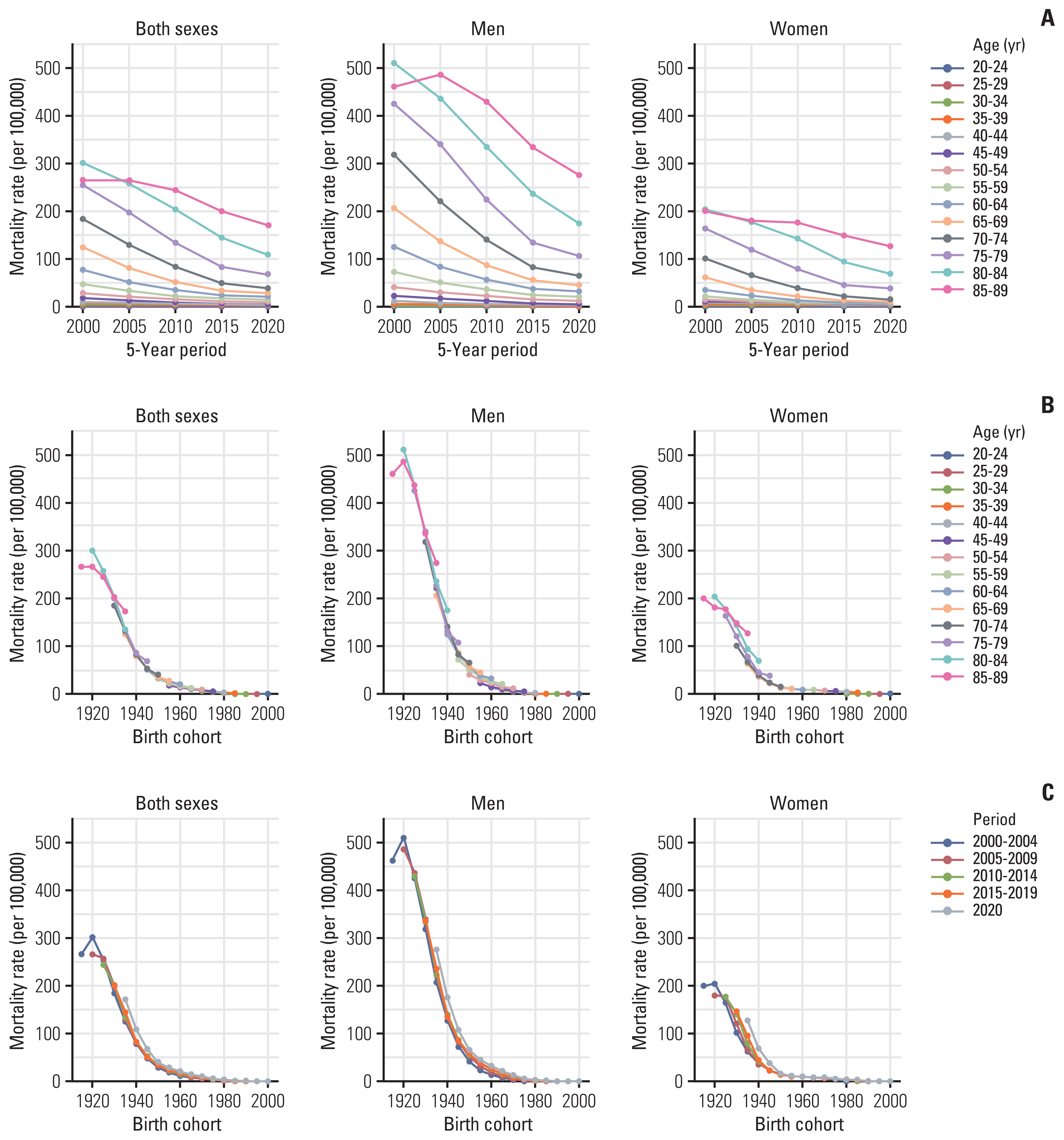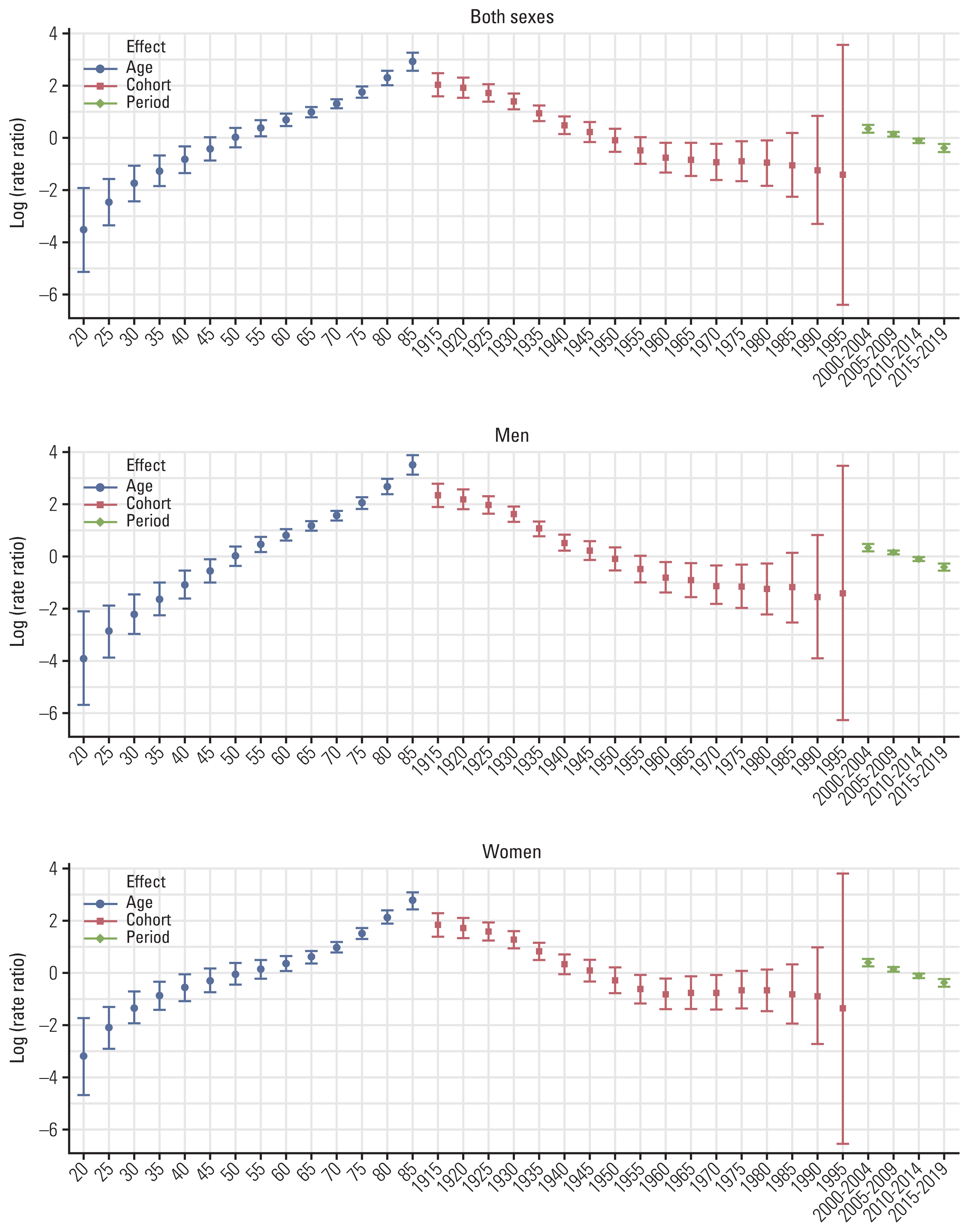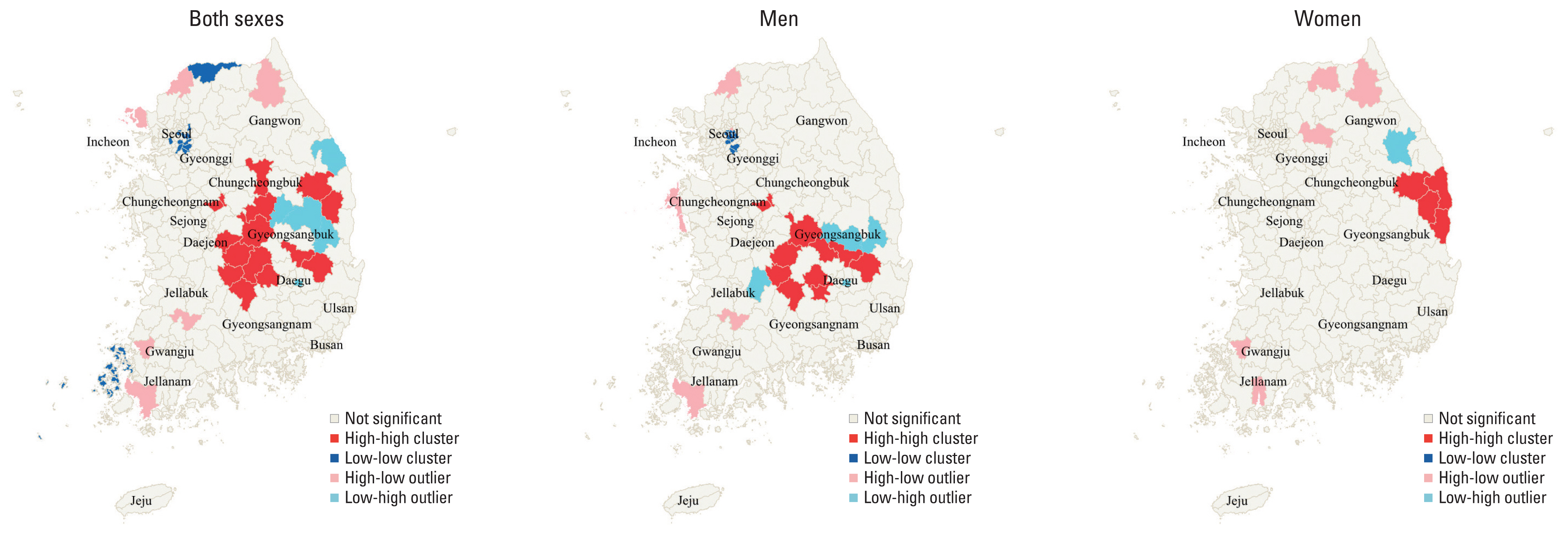Cancer Res Treat.
2023 Apr;55(2):603-617. 10.4143/crt.2022.307.
Descriptive Analysis of Gastric Cancer Mortality in Korea, 2000-2020
- Affiliations
-
- 1Department of Preventive Medicine, Seoul National University College of Medicine, Seoul, Korea
- 2Integrated Major in Innovative Medical Science, Seoul National University College of Medicine, Seoul, Korea
- 3Department of Preventive Medicine, Keimyung University School of Medicine, Daegu, Korea
- 4Medical Research Center, Genomic Medicine Institute, Seoul National University College of Medicine, Seoul, Korea
- 5Cancer Research Institute, Seoul National University, Seoul, Korea
- KMID: 2541247
- DOI: http://doi.org/10.4143/crt.2022.307
Abstract
- Purpose
This study aimed to examine secular trends, age-period-cohort effects, and geographical differences in gastric cancer (GC) mortality in Korea.
Materials and Methods
Using cause of death data from the Korean Statistical Information Service for GC from 2000 to 2020, we calculated average annual percentage changes (AAPCs) in the age-standardized mortality of GC in 17 cities and provinces through joinpoint regression. Decomposition of age, period, and cohort effects on GC mortality were elucidated by applying a log-linear model and an intrinsic estimate method. Spatial patterns and the degree of spatial clustering in 250 administrative regions were explored via Moran’s I statistics. Stratification by sex was performed for all analyses.
Results
The age-standardized mortality of GC per 100,000 persons declined from 29.0 in 2000 to 7.9 in 2020 (AAPC, -6.28%). Age-period-cohort analyses of GC mortality showed a downward trend among five-year age groups from age 20-89 years across five-year periods from 2005-2020 and five-year birth cohorts from 1920-2000. Overall, the younger birth cohort showed lower mortality rates than the older cohort within the same period. In 2020, clusters of high GC mortality were observed in the central area for men (Chungcheongbuk, Jeollabuk, Gyeongsangbuk, and Gyeongsangnam) and in the eastern area for women (Gyeongsangbuk).
Conclusion
This study identified a downward trend in GC mortality among men and women from 2000 to 2020 in Korea. This trend was mainly attributed to birth cohort rather than period effects. Spatial analysis showed high GC mortality in the Chungcheong and Gyeongsangbuk areas.
Keyword
Figure
Reference
-
References
1. Sung H, Ferlay J, Siegel RL, Laversanne M, Soerjomataram I, Jemal A, et al. Global cancer statistics 2020: GLOBOCAN estimates of incidence and mortality worldwide for 36 cancers in 185 countries. CA Cancer J Clin. 2021; 71:209–49.
Article2. Wong MCS, Huang J, Chan PS, Choi P, Lao XQ, Chan SM, et al. Global incidence and mortality of gastric cancer, 1980–2018. JAMA Netw Open. 2021; 4:e2118457.
Article3. G. B. D. Stomach Cancer Collaborators. The global, regional, and national burden of stomach cancer in 195 countries, 1990–2017: a systematic analysis for the Global Burden of Disease study 2017. Lancet Gastroenterol Hepatol. 2020; 5:42–54.4. Kim JH, Han KD, Lee JK, Kim HS, Cha JM, Park S, et al. Association between the National Cancer Screening Programme (NSCP) for gastric cancer and oesophageal cancer mortality. Br J Cancer. 2020; 123:480–6.
Article5. Ministry of Health and Welfare Korea. National cancer screening guideline 2018. Sejong: Ministry of Health and Welfare;2018.6. Jun JK, Choi KS, Lee HY, Suh M, Park B, Song SH, et al. Effectiveness of the Korean National Cancer Screening Program in reducing gastric cancer mortality. Gastroenterology. 2017; 152:1319–28.
Article7. Hong S, Won YJ, Lee JJ, Jung KW, Kong HJ, Im JS, et al. Cancer statistics in Korea: incidence, mortality, survival, and prevalence in 2018. Cancer Res Treat. 2021; 53:301–15.
Article8. Heo J, Jeon SY, Oh CM, Hwang J, Oh J, Cho Y. The unrealized potential: cohort effects and age-period-cohort analysis. Epidemiol Health. 2017; 39:e2017056.
Article9. Choi Y, Gwack J, Kim Y, Bae J, Jun JK, Ko KP, et al. Long term trends and the future gastric cancer mortality in Korea: 1983–2013. Cancer Res Treat. 2006; 38:7–12.
Article10. Song M, Kang D, Yang JJ, Choi JY, Sung H, Lee Y, et al. Age and sex interactions in gastric cancer incidence and mortality trends in Korea. Gastric Cancer. 2015; 18:580–9.
Article11. Rana N, Gosain R, Lemini R, Wang C, Gabriel E, Mohammed T, et al. Socio-demographic disparities in gastric adenocarcinoma: a population-based study. Cancers (Basel). 2020; 12:157.
Article12. Li X, Deng Y, Tang W, Sun Q, Chen Y, Yang C, et al. Urban-rural disparity in cancer incidence, mortality, and survivals in Shanghai, China, during 2002 and 2015. Front Oncol. 2018; 8:579.
Article13. Mokdad AH, Dwyer-Lindgren L, Fitzmaurice C, Stubbs RW, Bertozzi-Villa A, Morozoff C, et al. Trends and patterns of disparities in cancer mortality among US counties, 1980–2014. JAMA. 2017; 317:388–406.
Article14. Ruiz EF, Torres-Roman JS, Servan SA, Martinez-Herrera JF, Arce-Huamani MA, Carioli G, et al. Trends and geographic pattern of stomach cancer mortality in Peru. Cancer Epidemiol. 2019; 58:193–8.
Article15. Ma C, Congly SE, Chyou DE, Ross-Driscoll K, Forbes N, Tsang ES, et al. Factors associated with geographic disparities in gastrointestinal cancer mortality in the United States. Gastroenterology. 2022; 163:437–48.
Article16. Lee J, Sa J. Regional disparities in healthy eating and nutritional status in South Korea: Korea National Health and Nutrition Examination Survey 2017. Nutr Res Pract. 2020; 14:679–90.
Article17. Ha K, Song Y, Kim HK. Regional disparities in the associations of cardiometabolic risk factors and healthy dietary factors in Korean adults. Nutr Res Pract. 2020; 14:519–31.
Article18. Oh WS, Yoon S, Noh J, Sohn J, Kim C, Heo J. Geographical variations and influential factors in prevalence of cardiometabolic diseases in South Korea. PLoS One. 2018; 13:e0205005.
Article19. Kim B. Regional disparity in adult obesity prevalence, and its determinants. J Health Info Stat. 2021; 46:410–9.
Article20. Kang JH, Jung CY, Park KS, Huh JS, Oh SY, Kwon JH. Community care for cancer patients in rural areas: an integrated regional cancer center and public health center partnership model. J Hosp Palliat Care. 2021; 24:226–34.
Article21. Korean Statistical Information Service [Internet]. Daejeon: Statistics Korea;2022. [cited 2022 Sep 6]. Available from: https://kosis.kr/index/index.do .22. Kim HJ, Fay MP, Feuer EJ, Midthune DN. Permutation tests for joinpoint regression with applications to cancer rates. Stat Med. 2000; 19:335–51.
Article23. National Cancer Institute. Joinpoint trend analysis software: number of joinpoints [Internet]. Bethesda, MD: National Cancer Institute;2022. [cited 2022 Sep 6]. Available from: https://surveillance.cancer.gov/help/joinpoint/setting-parameters/method-and-parameters-tab/number-of-joinpoints .24. Esri. ArcGIS program: data classification methods [Internet]. Seoul: Esri;2022. [cited 2022 Sep 6]. Available from: https://pro.arcgis.com/en/pro-app/latest/help/mapping/layer-properties/data-classification-methods.htm .25. Jenks GF. The data model concept in statistical mapping, 1967. Frenzel K, editor. International yearbook of cartography. 7. C. Gutersloh: Vertelsmans Verlag;1967. p. 186–90.26. Anselin L. Local Indicators of Spatial Association-LISA. Geogr Anal. 1995; 27:93–115.
Article27. Diaz P, Valenzuela Valderrama M, Bravo J, Quest AFG. Helicobacter pylori and gastric cancer: adaptive cellular mechanisms involved in disease progression. Front Microbiol. 2018; 9:5.28. Shin A, Park S, Shin HR, Park EH, Park SK, Oh JK, et al. Population attributable fraction of infection-related cancers in Korea. Ann Oncol. 2011; 22:1435–42.
Article29. Ko KP, Shin A, Cho S, Park SK, Yoo KY. Environmental contributions to gastrointestinal and liver cancer in the Asia-Pacific region. J Gastroenterol Hepatol. 2018; 33:111–20.
Article30. Lim SH, Kwon JW, Kim N, Kim GH, Kang JM, Park MJ, et al. Prevalence and risk factors of Helicobacter pylori infection in Korea: nationwide multicenter study over 13 years. BMC Gastroenterol. 2013; 13:104.
Article31. Lee S, Jun JK, Suh M, Park B, Noh DK, Jung KW, et al. Gastric cancer screening uptake trends in Korea: results for the National Cancer Screening Program from 2002 to 2011: a prospective cross-sectional study. Medicine (Baltimore). 2015; 94:e533.32. Ryu JE, Choi E, Lee K, Jun JK, Suh M, Jung KW, et al. Trends in the performance of the Korean National Cancer Screening Program for gastric cancer from 2007 to 2016. Cancer Res Treat. 2022; 54:842–9.
Article33. Suh YS, Lee J, Woo H, Shin D, Kong SH, Lee HJ, et al. National cancer screening program for gastric cancer in Korea: Nationwide treatment benefit and cost. Cancer. 2020; 126:1929–39.
Article34. Chen ZD, Zhang PF, Xi HQ, Wei B, Chen L, Tang Y. Recent advances in the diagnosis, staging, treatment, and prognosis of advanced gastric cancer: a literature review. Front Med (Lausanne). 2021; 8:744839.
Article35. Machlowska J, Baj J, Sitarz M, Maciejewski R, Sitarz R. Gastric cancer: epidemiology, risk factors, classification, genomic characteristics and treatment strategies. Int J Mol Sci. 2020; 21:4012.
Article36. Sitarz R, Skierucha M, Mielko J, Offerhaus GJA, Maciejewski R, Polkowski WP. Gastric cancer: epidemiology, prevention, classification, and treatment. Cancer Manag Res. 2018; 10:239–48.
Article37. Jung HK, Kang SJ, Lee YC, Yang HJ, Park SY, Shin CM, et al. Evidence-based guidelines for the treatment of Helicobacter pylori infection in Korea 2020. Gut Liver. 2021; 15:168–95.38. Lee JH, Ahn JY, Choi KD, Jung HY, Kim JM, Baik GH, et al. Nationwide antibiotic resistance mapping of Helicobacter pylori in Korea: a prospective multicenter study. Helicobacter. 2019; 24:e12592.39. Lee JW, Kim N, Kim JM, Nam RH, Chang H, Kim JY, et al. Prevalence of primary and secondary antimicrobial resistance of Helicobacter pylori in Korea from 2003 through 2012. Helicobacter. 2013; 18:206–14.
Article40. Hwang TJ, Kim N, Kim HB, Lee BH, Nam RH, Park JH, et al. Change in antibiotic resistance of Helicobacter pylori strains and the effect of A2143G point mutation of 23S rRNA on the eradication of H. pylori in a single center of Korea. J Clin Gastroenterol. 2010; 44:536–43.
Article41. Kim JM, Kim JS, Jung HC, Kim N, Kim YJ, Song IS. Distribution of antibiotic MICs for Helicobacter pylori strains over a 16-year period in patients from Seoul, South Korea. Antimicrob Agents Chemother. 2004; 48:4843–7.
Article42. Lim SH, Kim N, Kwon JW, Kim SE, Baik GH, Lee JY, et al. Trends in the seroprevalence of Helicobacter pylori infection and its putative eradication rate over 18 years in Korea: a cross-sectional nationwide multicenter study. PLoS One. 2018; 13:e0204762.
Article43. Lee JH, Choi KD, Jung HY, Baik GH, Park JK, Kim SS, et al. Seroprevalence of Helicobacter pylori in Korea: a multicenter, nationwide study conducted in 2015 and 2016. Helicobacter. 2018; 23:e12463.44. Nam SY, Park BJ, Ryu KH, Nam JH. Effect of Helicobacter pylori eradication on the regression of gastric polyps in National Cancer Screening Program. Korean J Intern Med. 2018; 33:506–11.
Article45. Nam SY, Park BJ, Ryu KH, Nam JH. Effect of Helicobacter pylori infection and its eradication on the fate of gastric polyps. Eur J Gastroenterol Hepatol. 2016; 28:449–54.
Article46. Kim HJ, Kim YJ, Seo SI, Shin WG, Park CH. Impact of the timing of Helicobacter pylori eradication on the risk of development of metachronous lesions after treatment of early gastric cancer: a population-based cohort study. Gastrointest Endosc. 2020; 92:613–22.
Article47. Jeong O, Park YK. Clinicopathological features and surgical treatment of gastric cancer in South Korea: the results of 2009 nationwide survey on surgically treated gastric cancer patients. J Gastric Cancer. 2011; 11:69–77.
Article48. Park CH, Yang DH, Kim JW, Kim JH, Kim JH, Min YW, et al. Clinical practice guideline for endoscopic resection of early gastrointestinal cancer. Clin Endosc. 2020; 53:142–66.
Article49. Yu J, Huang C, Sun Y, Su X, Cao H, Hu J, et al. Effect of laparoscopic vs open distal gastrectomy on 3-year disease-free survival in patients with locally advanced gastric cancer: the CLASS-01 randomized clinical trial. JAMA. 2019; 321:1983–92.
Article50. Meng FS, Zhang ZH, Wang YM, Lu L, Zhu JZ, Ji F. Comparison of endoscopic resection and gastrectomy for the treatment of early gastric cancer: a meta-analysis. Surg Endosc. 2016; 30:3673–83.
Article51. Bang YJ, Kim YW, Yang HK, Chung HC, Park YK, Lee KH, et al. Adjuvant capecitabine and oxaliplatin for gastric cancer after D2 gastrectomy (CLASSIC): a phase 3 open-label, randomised controlled trial. Lancet. 2012; 379:315–21.
Article52. Sakuramoto S, Sasako M, Yamaguchi T, Kinoshita T, Fujii M, Nashimoto A, et al. Adjuvant chemotherapy for gastric cancer with S-1, an oral fluoropyrimidine. N Engl J Med. 2007; 357:1810–20.
Article53. National Cancer Center. Clinical Oncology Network for uNifying Electronic mediCal daTa (CONNECT) [Internet]. Goyang: National Cancer Center;2022. [cited 2022 Spe 6]. Available from: https://cancerportal.kr/ .54. Cho S, Chang Y, Kim Y. Cancer patients’ utilization of tertiary hospitals in Seoul before and after the benefit expansion policy. J Prev Med Public Health. 2019; 52:41–50.
Article55. Won YJ, Jung KW, Oh CM, Park EH, Kong HJ, Lee DH, et al. Geographical variations and trends in major cancer incidences throughout Korea during 1999–2013. Cancer Res Treat. 2018; 50:1281–93.
Article






